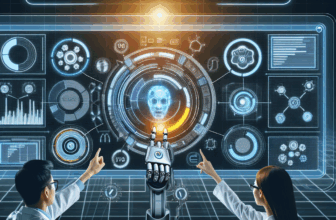Revolutionizing Product Prototype Testing: Unlocking the Benefits of AI-Driven Insights
Table of Contents
- 1. Introduction to Product Prototype Testing
- 2. The Role of AI in Product Development
- 3. Advantages of AI-Driven Insights in Prototype Testing
- 4. Methodologies for Implementing AI in Prototype Testing
- 5. Case Studies: Success Stories
- 6. Overcoming Challenges in AI Integration
- 7. Future Trends in AI-Driven Product Testing
- 8. Conclusion and Key Takeaways
- FAQ
- Resources
1. Introduction to Product Prototype Testing
Product prototype testing is a crucial phase in the product development lifecycle. It serves as a bridge between conceptualization and the final product launch. During this phase, prototypes, which are preliminary versions of a product, are evaluated for functionality, usability, and market viability. The insights gained from prototype testing can significantly impact the product's design, features, and overall success in the market.
The traditional approach to prototype testing often relies on manual processes, which can be time-consuming, prone to bias, and may not yield comprehensive results. With the advent of Artificial Intelligence (AI), a transformative shift is underway, allowing for more insightful, efficient, and accurate testing methods.
1.1 Understanding Prototype Testing Methods
Prototype testing methods vary widely depending on the product's industry, complexity, and intended use. Common methods include:
- User testing: Involving real users to gather feedback on the functionality and usability of a prototype.
- A/B testing: Comparing two versions of a product to determine which performs better.
- Simulations: Using computer-generated models to predict how a product will behave in real-world scenarios.
- Focus groups: Involving small groups of target audience members to discuss and evaluate the product.
1.2 Importance of Prototype Testing
Prototype testing is vital for several reasons:
- Risk reduction: Identifying and addressing design flaws before full-scale production.
- Cost efficiency: Minimizing financial investments by detecting issues early.
- User-centered design: Ensuring the product meets user needs and expectations.
2. The Role of AI in Product Development
AI technologies are increasingly being integrated into various stages of product development, offering unprecedented capabilities that can streamline processes, enhance decision-making, and unlock new levels of insight.
2.1 AI Technologies in Product Development
Some of the AI technologies particularly relevant to product testing include:
- Machine Learning (ML): Enables systems to learn from data and improve over time without being explicitly programmed.
- Natural Language Processing (NLP): Allows tools to understand, interpret, and respond to human language, facilitating user feedback analysis.
- Computer Vision: Empowers machines to interpret and make decisions based on visual data, essential for product design evaluations.
2.2 Enhancing Data Collection and Analysis
AI allows for the automation of data collection from diverse sources, providing more comprehensive insights. By analyzing user interactions with prototypes using machine learning algorithms, developers can identify trends and issues that may not be immediately visible.
2.3 Real-Time Feedback Loops
AI tools enable real-time feedback collection during testing phases. Immediate analysis of users’ interactions lead to rapid iterations in design, ultimately speeding up the testing process and enhancing user satisfaction.
3. Advantages of AI-Driven Insights in Prototype Testing
AI-driven approaches provide numerous benefits in the context of product prototype testing, fundamentally reshaping how developers think about user feedback and prototypes.
3.1 Improved Accuracy and Precision
Traditional prototype testing methods can often be subjective. In contrast, AI provides objective data that can lead to more informed decisions. For example, by utilizing computer vision technology, designers can gain precise metrics on how users interact with a prototype.
3.2 Scalability of Testing Processes
Once an AI system is implemented, scaling the testing process becomes much easier. AI tools can handle vast amounts of data efficiently, allowing for high-volume user testing without a proportional increase in resources or manpower.
3.3 Speeding Up the Iteration Process
AI speeds up the product development cycle through real-time data analysis. By processing user feedback instantly, developers can quickly implement necessary changes, reducing time-to-market significantly.
3.4 Enabling Predictive Analytics
With predictive analytics, AI can forecast trends in user behavior, allowing developers to anticipate and address potential concerns before they escalate into significant issues.
3.5 User-Centric Design Optimization
AI tools provide insights into user preferences and behaviors, enabling a more user-centric design approach. This can foster greater user engagement and satisfaction, ultimately leading to a more commercially successful product.
4. Methodologies for Implementing AI in Prototype Testing
Implementing AI into prototype testing requires a strategic approach to effectively leverage its capabilities.
4.1 Defining Clear Objectives
Before integrating AI, it's essential to define clear objectives for what the organization hopes to achieve. Whether it’s improving product quality, reducing time-to-market, or enhancing user experience, having a target can guide the implementation process.
4.2 Selecting Appropriate AI Tools and Technologies
Choosing the right AI tools is critical. Depending on the organization’s needs, this could range from machine learning frameworks for analysis to natural language processing tools for gathering user feedback.
4.3 Training and Integration of Staff
Educating staff on AI technologies and integrating them into existing workflows is crucial for successful implementation. Workshops, training sessions, and pilot projects can help facilitate this transition.
4.4 Establishing a Feedback Loop
Setting up a continuous feedback loop is essential to ensure that the AI system evolves with the product and the user’s changing preferences. This ensures the long-term relevancy of the insights generated.
4.5 Measuring Success and ROI
After implementation, organizations should measure the success of AI integration through defined KPIs. Evaluating the return on investment helps determine if the integration has met its objectives.
5. Case Studies: Success Stories
Examining real-world applications of AI in product prototype testing reveals its potential and effectiveness.
5.1 Case Study: Proto Labs
Proto Labs is a digital manufacturing company that adopted AI tools to optimize their prototype testing services. By using predictive analytics, they improved their ability to assess market readiness and streamline production processes.
5.2 Case Study: Nike
Nike has developed prototypes of shoes using AI-driven insights on customer preferences. By integrating machine learning into their design process, Nike has been able to produce highly tailored products that resonate well with their target audience.
5.3 Case Study: Unilever
Unilever implemented AI systems to analyze customer reviews of their products. The insights gained have allowed them to refine existing products and launch new ones that address consumer preferences more effectively.
6. Overcoming Challenges in AI Integration
Despite its advantages, integrating AI into prototype testing is not without challenges.
6.1 Data Privacy and Ethics
Ensuring user data privacy and navigating ethical considerations is crucial in implementing AI technologies, especially when involving personal user data.
6.2 Resistance to Change
Staff may be resistant to adopting new technologies. Clear communication about the benefits of AI integration can aid in alleviating concerns and fostering a culture of innovation.
6.3 Skills Gap and Training Needs
Organizations often face a skills gap when integrating AI solutions. Investing in staff training and hiring skilled personnel is essential for successful implementation.
6.4 Technology Limitations
AI tools are continually evolving, but they come with certain limitations. Understanding these limitations helps set realistic expectations during the implementation phase.
7. Future Trends in AI-Driven Product Testing
The future of AI in product prototype testing looks promising, with several emerging trends likely to shape the landscape.
7.1 Increased Personalization
As AI continues to evolve, future products may rely on increasingly personalized testing processes that adapt to user responses on an individual level.
7.2 Integration of Augmented Reality (AR)
The integration of AR with AI can create immersive prototype testing experiences where users interact with products in virtual environments, providing real-time feedback.
7.3 Continuous Learning Systems
AI systems will likely evolve into continuous learning frameworks, allowing them to adapt and improve based on ongoing user feedback over time.
7.4 Collaborative AI Tools
The emergence of collaborative AI tools will enhance teamwork among product developers, designers, and stakeholders, leading to improved decision-making and innovation.
8. Conclusion and Key Takeaways
AI is revolutionizing how organizations approach product prototype testing. The benefits are clear: enhanced accuracy, speedier processes, and more informed decision-making can significantly boost product development outcomes. However, for successful integration, organizations must define clear objectives, choose the right tools, and invest in staff training.
Future trends indicate a shift towards increased personalization and improved integrations of AI with emerging technologies, promising a dynamic landscape for product testing.
FAQ
Q: How does AI enhance prototype testing?
A: AI significantly enhances prototype testing through real-time data analysis, predictive analytics, and objective insights that facilitate informed decision-making.
Q: What are the main challenges of using AI in prototype testing?
A: Key challenges include data privacy and ethics, resistance to change within organizations, a skills gap among staff, and the limitations of current AI technology.
Q: Can small businesses benefit from AI-driven prototype testing?
A: Yes, small businesses can leverage AI tools to optimize their prototype testing processes, ultimately improving product quality and reducing time-to-market.
Resources
| Source | Description | Link |
|---|---|---|
| AI in Product Development | A comprehensive review of AI applications in product development. | Forbes Article |
| Machine Learning for Design | A deep dive into how machine learning can assist in product design and prototype testing. | Smartsheet Guide |
| Ethics of AI in Design | Exploration of the ethical implications of AI in design and prototype testing. | Al Jazeera Article |
Disclaimer
This article is produced by A.I. and is in Beta Testing. It serves as an introductory exploration of the subject matter and is meant for informational purposes only. While every effort has been made to ensure accuracy, please consult with professionals in the field for more specialized and personalized guidance.










